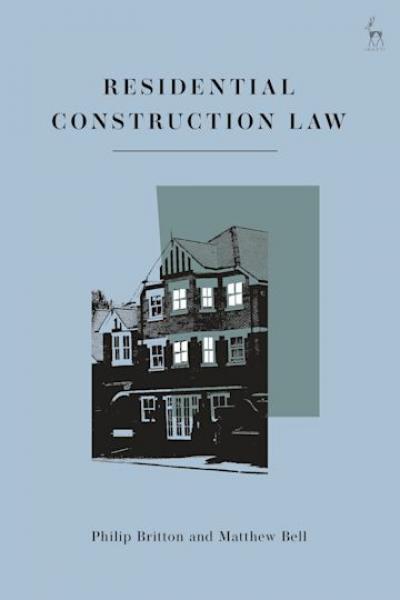Book review: Residential Construction Law by Philip Britton and Matthew Bell (Hart, 2021)
Posted:
Time to read:
A residential building scandal that will cost billions of pounds in total to remediate is a sadly familiar story across the common law world. New Zealand is suffering what has been styled the ‘leaky homes’ scandal, whereby many houses and apartments were not able to withstand the weather, leading to rot, corrosion, mould and dampness. Australian homeowners have been the victim of their own cladding scandal, with the Lacrosse Apartment fire exposing a series of failures by several parties involved in the design and construction of a high-rise residential building. Meanwhile, in the Republic of Ireland, the ‘crumbling homes’ scandal (caused by excessive amounts of mica in construction materials) has led to calls for the state to intervene through regulatory reform and enforcement when insurers have refused to provide cover.
When it comes to problems with the construction of residential buildings, there is compelling evidence that consumers in a number of countries experience high levels of defects. The 2019-20 National New Home Customer Satisfaction Survey in the UK (reporting on new UK homes with Buildmark warranties) identified that 94% had notified problems to their developer since moving in, while in New Zealand, the Building Research Association NZ’s survey in 2018 found that 83% of respondents had to call their builder back after the job was complete.

It is in this context that Philip Britton and Matthew Bell have written Residential Construction Law, published by Hart. It is the first systematic overview of the legal framework that governs the construction of residential or domestic dwelling units. Britton and Bell are right to observe that the field for them has been left clear. Beyond the classic textbooks on construction law (such as Keating on Construction Contracts, Hudson on Construction Contracts, and Wilmot-Smith on Construction Contracts), recent construction law publications have focussed on claims or standard form contracts, with David Mosey’s recent work on collaborative procurement and relational contracting being the stand out exception. Despite its acknowledged importance, very little has been written about the problems that residential occupiers face when confronted by defective construction.
Both authors are well placed to break new ground. Philip Britton is a legend of the Society of Construction Law, with several published papers on the issues facing residential construction, having been the Director of the Centre of Construction Law at King’s College London, as well as a Senior Fellow at the University of Melbourne. Matthew Bell is a Senior Lecturer and Co-Director of Studies for Construction Law at the University of Melbourne, also publishing widely in this field. They also benefited from specialist contributions from Deirdre Ní Fhloinn (whose research on consumer remedies for defective housing in Ireland is a valuable contribution to this book) and Kim Vernau (CEO of BLP, who provided a specialist contribution in respect of insurance and warranties).
The book is sizeable, running to 696 pages. It is also very up to date, covering recent evidence given at the Grenfell Tower Inquiry, as well as 2020 and early 2021 decisions such as the Court of Appeal decision regarding damages following a negligent homebuyer survey report in Large v Hart. The book is divided into ten substantive chapters, each covering a particular subject matter (such as insurance or inspections) rather than a doctrinal rule set. This structure pervades the book: the building blocks of each chapter are a series of case studies illustrating the doctrinal issues and problems created. The initial England and Wales focus is then contrasted with the situation found in Australia, New Zealand, Ireland and Scotland. As a result, the book is dense with material and information. The book is clearly written, but this is not a casual read. Instead, it is comprehensive and authoritative.

It is also an exercise in comparative law. On account of the structure of the book, it demonstrates the threadbare protection given to English and Welsh consumers compared to residential occupiers in the different jurisdictions in the Commonwealth of Australia. This difference is starkly revealed in chapter 4, on contract law in residential construction. Britton and Bell demonstrate that, save for limited statutory intervention through the Consumer Rights Act 2015, there is limited assistance to the English/Welsh residential owner. We are given, however, a detailed account of how pre-contractual representations and implied terms operate in the residential context by reference to a detailed analysis of the case law. The reader is then reminded, through one example of the many clear and useful tables in this book, that the system of statutory warranties under state-based Australian schemes cuts through this detail to make relief more accessible to the homeowner, a model which was copied by New Zealand following the ‘leaky buildings’ crisis. The sky has not fallen in so far in those jurisdictions, making the limited intervention of the England and Wales Defective Premises Act 1972 look unduly conservative.
This book is, through and through, a work about construction law. There is still a gap between the highly important work carried out by academics such as Dave Cowan, Helen Carr and Alison Wallace (see, for example, their book Ownership, Narrative, Things on shared ownership, and the experience of construction defects under that form of tenure (such as their discussion of defects and repairs at 162-165), or recent research into mixed tenure and energy retrofit by Susan Bright, David Weatherall and Roxana Willis, and the construction law literature which has reached its new height in Residential Construction Law. The residential owner’s voice, particularly when it comes to leasehold, still goes unheard. What this book provides is a mooring in construction law to which future doctrinal or socio-legal studies can be secured. Chapter 11 of Residential Construction Law (on multi-unit developments, such as blocks of flats) is a clear account of the construction law issues in this field, but there is still a space to be filled between construction law and housing and residential property law.

By contrast with the detailed and powerful introduction, the concluding chapter is short. Instead, Phillip Britton’s recent article, ‘Post-Grenfell reform: rethinking civil liability’ (2021) Construction Law Journal 37(4) 243 provides the critical analysis of what he thinks are the reforms that need to be undertaken in this field: as he notes in the conclusion that article, “The cladding scandal (or nightmare) could be the moment to take stock of more aspects of bad practice and inadequate regulation in UK housebuilding than seem so far to be in anyone’s sights.” I anticipate that a second edition would follow the reaction to the report arising from the Grenfell Tower Inquiry, which must be expected at some point in 2022 or 2023.
Is it correct that, when it comes to residential construction, “‘hope’ may come perilously close to denial”? Philip Britton and Matthew Bell have accumulated decades of research and teaching, culminating in this authoritative book, to provide something more tangible: the first comprehensive study of English common law residential construction law. This book is powerful rebuttal to any denial that there is something seriously wrong in this area, both in the UK and elsewhere.
How to cite this blogpost (Harvard style)
Sawtell, D. (2021) Book review: Residential Construction Law by Philip Britton and Matthew Bell (Hart, 2021) Available at: https://www.law.ox.ac.uk/housing-after-grenfell/blog/2021/12/book-review-residential-construction-law-philip-britton-and (Accessed [date])
Share:
